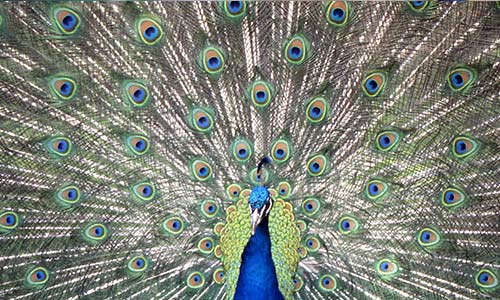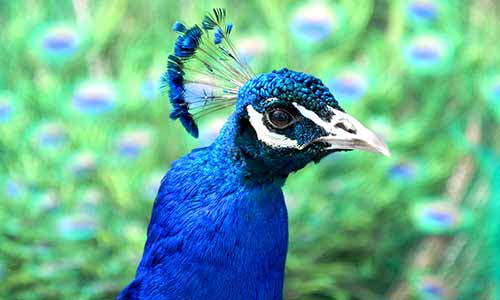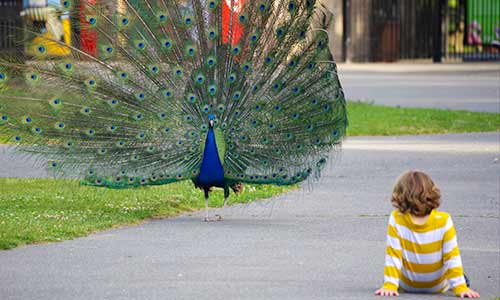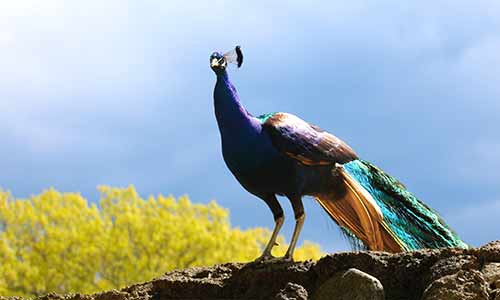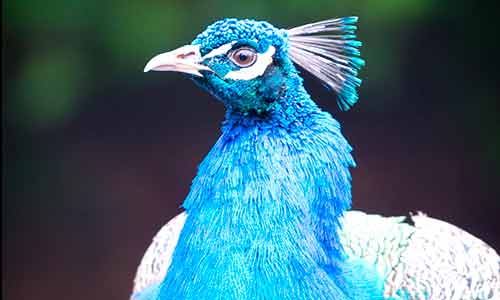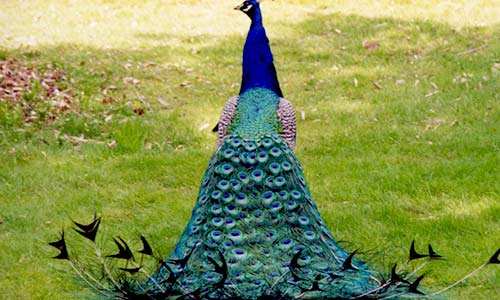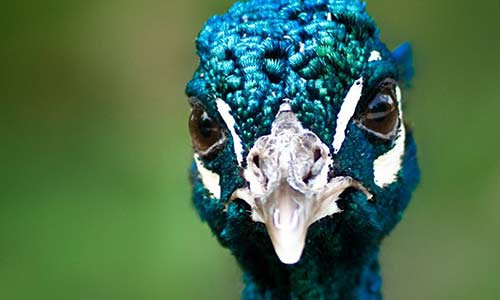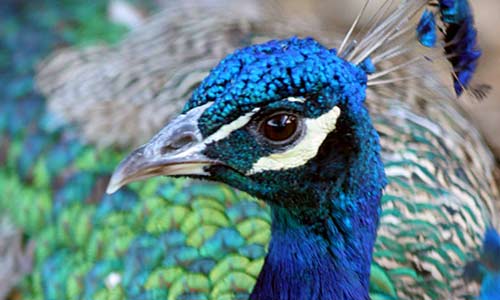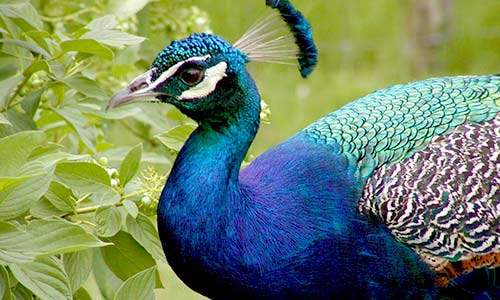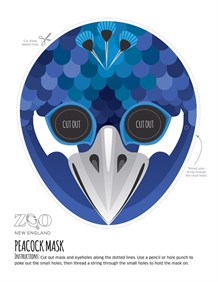Indian Blue Peafowl (Peacock)
Pavo cristatus
About the Indian Blue Peafowl (Peacock)

Geographic Range:
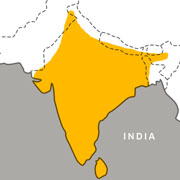
Class: Aves
Order: Galliformes
Family: Phasianidae
Genus: Pavo
Species: cristatus
Despite its large size, the Indian blue peafowl, better known as the peacock, is incredibly agile and will run or fly to escape predators. The male peafowl is a regal, shiny blue with patches of white above and below its eyes. A blue-tipped fan of feathers crowns its head and its long train of feathers trails behind like a royal cape. Males display their train feathers in a beautiful fan in order to attract a mate. The female peafowl has less dramatic coloring and plumage—it is predominantly white and brown with a metallic green upper breast, and its train is shorter and less ornate.
Peafowl Facts
Appearance:
The male peafowl has a shiny blue body, neck and head with patches of white below and above its eyes, and blue-tipped feathers on top of its head. The back of its wings are grayish-brown, and white feathers spread from its bottom. Males have a train of feathers at their rear, which is almost two-thirds of their body in length. Peacock feathers have patterns resembling eyespots. The peacock’s train is not the same as its tail. The train is made of up quills that keep feathers straight, and the real peacock tail is brown. The female peafowl has a white face, throat and belly, with a metallic green upper breast. Its back, head, and the back of its neck are brown or beige. Females have the same train of feathers, but they’re much shorter and don’t have the same eyespots.
Size:
Male peafowl are approximately 46 inches tall, while female peafowl are about 38 inches tall. Males can weigh up to 13 pounds, whereas females weigh between 6 and 9 pounds. They are known for their long train of tail feathers, which range from 4.5 to 5 feet in length, making up 60% of their total body length.
Diet:
These birds are omnivores, feasting on seeds, berries and insects.
Reproduction:
Peacock breeding season takes place from April to June. The courting process begins with males forming breeding territories called "leks," where they display their brightly-colored train feathers to passing females. This fan-like display can also serve as a territorial defense. During courtship, males sing loudly in tones of “ow-aaa, ow-aaa, ow-aaa!” to catch the attention of females. Females visit several leks, sometimes making repeat visits, to select a mate. The selection is often based on the size, brightness, and number of eyespots on the males’ train feathers.
After selection and mating, males leave and have no further involvement with the chicks or hen. After an incubation period of 27 to 30 days, females lay three to five eggs. The eggs are light brown, about 3-4 inches long, and weigh approximately 100 grams. Females can lay up to 12 eggs, with an average of three per clutch.
The mother cares for her babies, called peachicks, for about 7 to 9 weeks. Peachicks are approximately 5 inches long and weigh about 103 grams. They can leave the nest with their mother a few hours after hatching. Often, they climb on her back, and she flies them to a safe tree branch. Peachicks can feed themselves as soon as they are born.
Peafowl are considered juveniles for 1 to 3 years before reaching sexual maturity. Juvenile peacocks have dull, brown plumage and striped wings and tails. Male peafowl begin growing colored chests around 5 months of age. After one year, more brightly colored feathers start growing in, particularly in the tail region. By 3 years of age, males are fully mature with a metallic blue head coloration. Females reach full maturity at 1 year of age, remaining brown or beige.
Behavior:
This bird’s social structure consists of small groups of males, females, and possibly their offspring. During mating season, males are often solitary. Peacocks roam in the early morning and at dusk. During the middle of the day, when temperatures are higher, they often seek cover among forest trees. They prefer to roost in trees overnight.
Peafowl have 11 different calls, often using them as warnings to other animals that a predator is nearby. They make a honking sound when agitated. As territorial creatures, they often roost and feed in the same location. They defend themselves by shaking their fanned train feathers, pecking with their beaks, and clawing with their talons. Although seemingly flightless, peacocks are excellent jumpers and flyers. Despite their large size, they are very agile and can run or fly if they feel threatened.
Habitat/Range:
These birds are native to India, Sri Lanka, Pakistan, Bhutan, Bangladesh and Nepal. They can live in moist and dry forests.
Median Life Expectancy:
20 years in the wild
Threats:
Indian peafowl can be used in trade and used for their feathers. They are also kept as pets.
Role in their habitats:
Peafowl are predators and prey, and while they seek out smaller animals and insects, they run from land cats, like leopards and tigers.
Fun Facts:
- Most people call these birds peacocks, but that's the correct name for males; females are peahens, and males and females together are peafowl.
- There are three types of peafowl: Indian, green, and Congo.
- The Indian peafowl is the national bird of India.
- A group of peafowl is called an "ostentation" or "pride."
You Can Find This Animal in the Bird's World Habitat
Zoodopt
Zoodopts support the care and feeding of our animals, and with each purchase, we'll bring a little of the Zoo to you! Zoodopt today!
Kids' Corner
Make your own peacock mask in our Kids' Corner!
Did you Know?
Most people call these birds peacocks, which is the correct name for males. Females are peahens, and males and females together are peafowl.
You might also like
At Franklin Park Zoo:
At Stone Zoo:

